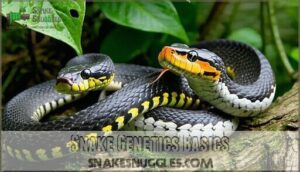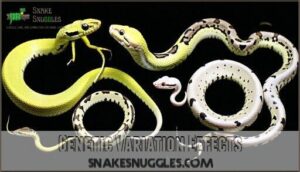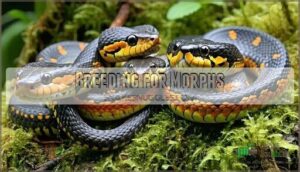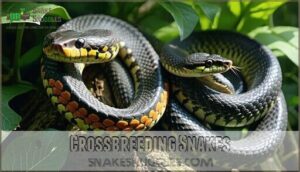This site is supported by our readers. We may earn a commission, at no cost to you, if you purchase through links.
 Breeding snakes for specific morphs means working with genetics to produce unique patterns and colors, like albino or piebald.
Breeding snakes for specific morphs means working with genetics to produce unique patterns and colors, like albino or piebald.
You’ll need to understand dominant, recessive, and even polygenic traits, as these determine how genes express themselves in offspring.
Think of it like mixing paint—some combinations create bold results, while others are subtler.
Tracking lineage is essential to avoid inbreeding and maintain healthy snakes. Be patient; it can take generations to achieve a desired morph.
And don’t forget ethics—prioritize the snakes’ well-being over aesthetics. Genetics is part science, part art, but the payoff is seeing those striking traits come to life!
Table Of Contents
- Key Takeaways
- Snake Genetics Basics
- Genetic Variation Effects
- Breeding for Morphs
- Gene Expression Factors
- Crossbreeding Snakes
- Morph Creation Methods
- Frequently Asked Questions (FAQs)
- Can snakes breed with different species of snakes?
- How much money do snake breeders make?
- What is morph breeding?
- How do dietary factors impact snake morph development?
- What are the effects of incubation temperature on morph traits?
- Can stress influence genetic expression in breeding snakes?
- How does habitat design affect offspring survival rates?
- What external factors impact morph color intensity?
- How do temperature variations affect morph development?
- What are common health issues in morph breeding?
- Conclusion
Key Takeaways
- Learn the basics of snake genetics, like dominant, recessive, and co-dominant traits, to predict morph outcomes more accurately.
- Track genetic lineages and avoid inbreeding to maintain healthy, vibrant snakes and reduce genetic health risks.
- Prioritize ethical breeding practices by balancing aesthetics and health, ensuring snakes thrive without compromising their well-being.
- Use tools like Punnett Squares or breeding calculators to refine your strategy and anticipate offspring traits effectively.
Snake Genetics Basics
Understanding snake genetics starts with the basics: traits are determined by specific genes, each inherited from the parents.
Traits in snakes are like genetic puzzles, passed down from parents to create stunning patterns and colors.
By learning how dominant, recessive, and co-dominant alleles interact, you’ll predict morph outcomes with accuracy and confidence.
Genetic Foundations of Traits
Snake genetics reveal a world of morph possibilities through traits like colors and patterns shaped by allele combinations.
Understanding these genetic foundations is key to mastering morph inheritance:
- Genetic inheritance transfers traits via dominant, recessive, or codominant genes.
- The genotype vs. phenotype concept explains how hidden genetics shape visible traits.
- Tools like Punnett Squares predict offspring outcomes—including gene expression and morph potential.
Strategic breeding, backed by this knowledge, guarantees you’re creating breathtaking snakes while preserving genetic diversity and avoiding harmful practices.
Allele Expression and DNA Sequencing
Every snake’s unique traits stem from allele dominance and genetic inheritance.
Sequencing technologies uncover the DNA blueprint, making gene mapping and mutation identification precise.
Whether you’re studying recessive genes, dominant genes, or codominant genes, decoding genetic mutations is like solving a puzzle.
Epigenetics adds depth, showing how environmental factors influence expression.
Mastering these tools gives you unparalleled control.
Gene Interaction and Trait Inheritance
Understanding how genes interact reveals the secrets of snake morph diversity.
Traits don’t work in isolation—dominant and recessive genes, codominance, and pleiotropy all play roles.
Epigenetics, modifier genes, and gene suppression tweak phenotypes, creating subtle variations.
Environmental influence further shapes expression, proving a snake’s appearance is more than just genetics.
Genotype sets the stage, but gene interactions and phenotypic outcomes make each snake uniquely stunning, like nature’s artful experiment in inheritance.
Genetic Variation Effects
When you explore genetic variation in snake breeding, you’ll see how different gene combinations influence patterns and colors.
Understanding these effects helps you predict morph outcomes more accurately, ensuring healthier and more interesting results.
Dominant and Recessive Patterns
Dominant genes in snakes shine easily, always expressed in morph traits—think of dominance expression as the showoff of genetics.
Recessive genes, meanwhile, remain hidden (recessive masking), surfacing only when paired, and heterozygous visuals add a splash of unpredictability, blending features.
A Punnett Square or snake genetics calculator helps predict homozygous traits and quirky snake morph combos, keeping your breeding strategies sharp and engaging every time.
Understanding the basics of snake color inheritance is key to successful breeding.
Polygenic Inheritance and Morphs
When breeding for morph traits, complex traits like subtle patterns or vibrant hues stem from multiple genes interacting—a process known as quantitative traits.
These traits often defy simple predictions due to the intricate dance of genetic inheritance in snakes.
Add in environmental influence, and the picture becomes even trickier.
Patience, keen observation, and understanding morph genetic inheritance are your best tools here.
By studying heritability estimates, you’ll start decoding how genetic traits shape outcomes, ensuring each pairing brings you closer to your ideal snake.
Gene Linkage and Morph Combinations
Gene linkage is like a genetic buddy system—when genes are close on a chromosome, they stick together, influencing snake morph combinations.
This means linked genes often pass as a package, shaping morph expression and creating unique genetic combinations.
A low crossover frequency keeps these traits bundled, while recombination rates dictate how often linked genes split.
By understanding these dynamics, you can predict stunning snake morph combinations or even polygenic traits, it’s like deciphering a puzzle where mutation combinations reveal breathtaking patterns and colors in your snakes.
Breeding for Morphs
Breeding for morphs lets you create snakes with eye-catching patterns and colors by understanding genetics and inheritance.
Breeding morphs combines science and art, unlocking stunning patterns and vibrant colors through smart genetic pairing.
By carefully selecting parent snakes, you can combine traits to produce offspring with unique and stunning appearances.
Selective Breeding for Desired Traits
Selective breeding lets you fine-tune snake morphs by focusing on morph prioritization and trait enhancement.
To hit your breeding goals without genetic bottlenecks, pair snakes thoughtfully and mix genetic combinations wisely.
Here’s how to keep it smart and ethical:
- Prioritize vibrant patterns or rare morphs for unique offspring.
- Rotate breeding pairs to maintain genetic diversity.
- Track lineage to avoid unintentional inbreeding.
- Balance aesthetics with health—no snake deserves compromised well-being for flashy traits.
Understanding snake morph genetics is essential for responsible breeding, and it helps in achieving breeding goals without compromising the well-being of the snakes.
Responsible Breeding Practices
Healthy snakes start with responsible breeding practices that prioritize genetic diversity and ethical sourcing.
Breeders should keep detailed lineage records to avoid inbreeding and monitor genetic health. Think of it like managing a family tree—without surprises! Regular health checks guarantee snakes thrive, while ethical sourcing prevents harmful shortcuts.
Breeders should also consider pre-breeding preparation essentials to optimize their snakes’ health.
- Promote buyer education to discourage harmful pairings.
- Prioritize health over aesthetics, ensuring vibrant, strong snakes.
- Avoid inbreeding, using unrelated snakes to maintain diversity.
- Champion breeding ethics, valuing welfare over profit.
Remember, breeding isn’t just science—it’s stewardship of life and genetics.
Tracking Dominant and Recessive Traits
In the context of Trait Visualization in snakes, understanding how dominant and recessive genes interact is key.
Dominant genes in snakes overshadow recessive ones unless both parents pass on recessive genes, revealing specific snake morph traits.
Use Punnett Squares to simplify Genotype Prediction and track breeding outcomes with precision.
This method helps you anticipate phenotypes and avoid surprises.
By mastering these tools, you’ll refine your breeding strategy, ensuring each pairing aligns with your goals.
Think of it as creating a genetic roadmap for your next morph masterpiece!
You can utilize a Punnett Square tool online to visualize potential offspring traits.
Gene Expression Factors
When you’re breeding snakes for specific morphs, understanding gene expression factors is essential for predicting outcomes.
These factors, including environmental influences, gene interactions, and sex-linked traits, directly shape how genetic potential translates into physical appearance.
Environmental Conditions and Gene Expression
Your snake’s surroundings are like nature’s control panel for genetic expression.
Environmental conditions tweak how genes show up as physical traits, or phenotypes.
- Temperature influence: Impacts pigmentation and pattern clarity.
- Humidity effects: Shapes scale texture and sheen.
- Lighting spectrum: Enhances pigment intensity, creating vibrant morphs.
- Incubation impact: Alters development, affecting genetic expression.
Mastering these conditions reveals stunning morph potential, blending genotype with seasonal variations for breathtaking results.
Epistasis and Gene Interaction
Epistasis, where one gene overrides another, spices up morph genetics.
These polygenic traits arise from intricate genetic interactions, producing unexpected results.
By understanding gene suppression and combinations, you’ll refine predictions and reveal unique genetic expression possibilities, proving that morph genetics is as much art as science.
Sex-Linked Inheritance and Morphs
Sex-linked inheritance adds a twist to snake morph breeding, making morph genetics even more intriguing.
Traits tied to sex chromosomes can create unique patterns due to hemi-zygosity effects. With ZW determination in snakes, you’ll notice fascinating outcomes.
- Sex-linked traits influence male/female morph differences.
- W-linked lethality affects offspring viability.
- Dosage compensation balances gene expression.
- Breeding adjustments accommodate inheritance quirks.
Mastering reptile genetics requires understanding these nuances for successful morph creation.
Crossbreeding Snakes
Crossbreeding snakes lets you combine traits from different species or morphs, creating entirely new patterns and colors.
By carefully selecting compatible pairs, you can produce hybrids with unique appearances, though it requires a solid understanding of genetics and potential risks.
Taxonomy and Hybridization
When exploring snake breeding, understanding species identification is key to successful hybrids.
Hybrid vigor can enhance traits, but hybrid fertility often complicates outcomes.
Taxonomic classification ensures compatible pairings, avoiding mismatches.
While hybridization introduces stunning morphs, it raises conservation concerns, like preserving biodiversity and managing unintended genetic variation.
Understanding a snake’s breeding temperature needs is vital for success.
Responsible breeding balances creativity with ethics, guaranteeing genetic diversity while respecting ecological boundaries—because even snakes deserve thoughtful matchmaking!
Crossbreeding and Morph Creation
Creating designer morphs through crossbreeding showcases the artistry of genetics. By blending gene combinations, you discover novel combinations and breathtaking patterns. Hybrid vigor often enhances health, making these snakes robust and unique.
- Produces vibrant, multi-layered patterns.
- Expands possibilities for ethical hybrids.
- Elevates morph breeding with innovative techniques.
Morph pairing offers endless creativity, transforming breeding techniques into a canvas of living art.
Risks and Benefits of Crossbreeding
Crossbreeding snakes offers exciting possibilities like hybrid vigor and novel traits, but it’s not without risks.
Poor genetic compatibility can cause defects, while unpredictable outcomes may harm genetic health. Ethical concerns arise when profit overshadows welfare, and improper management risks inbreeding or a genetic bottleneck.
Prioritize outcrossing and genetic diversity preservation to avoid:
- Reduced offspring viability
- Increased genetic disorders
- Loss of wild-type traits
- Long-term population decline
Morph Creation Methods
Creating unique snake morphs requires a mix of strategy, patience, and a solid grasp of genetics.
You’ll need to balance selective breeding techniques with ethical practices to guarantee healthy, visually stunning offspring.
Line Breeding and Gene Isolation
Line breeding refines traits by pairing related snakes, but inbreeding risks like genetic bottlenecks or the founder effect can harm genetic diversity.
Striking a balance is vital—secure mutation fixation without sacrificing biodiversity or snake health. Outcrossing to unrelated lines minimizes issues while maintaining desired traits.
| Term | Definition | Example |
|---|---|---|
| Inbreeding Risks | Health problems from breeding related snakes | Deformities, low fertility |
| Mutation Fixation | Locking in a desired genetic trait | Pied or Albino morphs |
| Genetic Bottleneck | Reduced genetic variation in a population | Small breeding pools |
Use heterozygous and homozygous pairings wisely, ensuring healthy, vibrant snakes for future generations.
Crossbreeding Different Morphs
Pairing snakes with complementary traits fosters hybrid vigor and novel combinations.
To achieve success:
- Match snakes based on genetic compatibility for desired trait interactions.
- Track morph genetic pairings to refine snake genetic combinations.
- Avoid overbreeding related reptiles to prevent health issues.
- Embrace unexpected outcomes—they often lead to stunning reptile genetic combinations and unique morphs.
Understanding dominant and recessive genes is vital for predicting offspring traits.
Crossbreeding creates endless possibilities!
Predicting Offspring Morphs
Predicting snake morphs feels like pieeing together a puzzle where science meets creativity. Using a Punnett Square simplifies Trait Inheritance, letting you visualize how Genotype vs Phenotype plays out in offspring.
It’s a handy tool for Probability Calculations, showing how dominant, recessive, or co-dominant genes influence outcomes. For example, breeding two het Pied snakes gives you a 25% chance of visually Pied offspring, 50% het Pied, and 25% normal.
If math isn’t your strong suit, a breeding calculator can save time and headaches. These tools streamline morph prediction by mapping genetic outcomes based on parental traits. They’re perfect for forecasting combinations like Albino or Pied morphs, ensuring you’re not left guessing.
Using a snake morph calculator can further refine predictions. With clear Probability of Inheritance and Visual Identification, predicting genetic outcomes becomes both practical and rewarding for breeders aiming to master morph creation.
Maintaining Genetic Diversity
Keeping genetic diversity alive in snake breeding is like maintaining a vibrant garden—you need fresh seeds.
Outcrossing benefits your collection by introducing diverse bloodlines, preventing genetic bottlenecks, and boosting health.
Wild-type importance can’t be overstated; they’re your genetic safety net.
Inbreeding avoidance isn’t just ethical—it’s smart.
Healthy, lively snakes with unique morphs thrive when you prioritize genetic inheritance in reptiles over shortcuts for quick snake morphs for sale.
Preventing Inbreeding Depression
Inbreeding can shrink genetic diversity, leading to weaker, less healthy snakes.
To avoid this, focus on:
- Outcrossing strategies to refresh the genetic pool.
- Keeping wild-type snakes in your collection for diversity.
- Practicing responsible pairing by tracking genetic backgrounds.
- Promoting breeder education about genetic health awareness.
A little planning guarantees your snakes thrive, not just look stunning!
Ethical Considerations in Snake Breeding
Breeding ethics demand prioritizing genetic diversity and health over flashy morphs.
Ignoring inbreeding risks for striking patterns can harm snakes long-term.
Embrace snake breeding best practices by avoiding sibling pairings, screening for disorders, and practicing responsible sales.
Breeder education is key—genetic responsibility guarantees healthier offspring.
Remember, snake breeding ethics mean creating beauty without compromising genetic health awareness or sustainability.
Frequently Asked Questions (FAQs)
Can snakes breed with different species of snakes?
In the context of mixing apples and oranges, snake species rarely interbreed.
While closely related species might hybridize, it’s uncommon and often results in sterile offspring.
So nature generally keeps those boundaries pretty firm.
How much money do snake breeders make?
Your income as a snake breeder depends on the morphs you produce, scale of operation, and market demand.
Some hobbyists make a few hundred dollars, while top breeders can earn thousands per clutch annually.
What is morph breeding?
Imagine creating living works of art.
Morph breeding means selectively pairing snakes with specific genetic traits to produce stunning colors and patterns.
It’s like mastering a genetic puzzle, revealing unique beauty with every new combination, which is a form of art.
How do dietary factors impact snake morph development?
A snake’s diet doesn’t directly influence morph development, but poor nutrition can stunt growth or cause health issues.
Balanced feeding guarantees proper physical development, maximizing a snake’s ability to reach its genetic potential visually and physically.
What are the effects of incubation temperature on morph traits?
Incubation temperature directly affects snake development, influencing traits like size, color vibrancy, or pattern clarity.
Warmer temperatures can intensify pigmentation, while cooler settings may slow growth but improve pattern definition.
Slight shifts yield intriguing morph variations!
Can stress influence genetic expression in breeding snakes?
Stress can alter genetic expression in breeding snakes, mainly affecting health, growth, and fertility.
Prolonged stress may influence epigenetics, potentially impacting offspring traits, so creating a calm, consistent environment is essential for breeding success.
How does habitat design affect offspring survival rates?
A well-designed habitat acts like a safety net, ensuring offspring thrive by mimicking natural conditions.
Provide proper heat gradients, hide options, and humidity levels to reduce stress and boost survival rates in young snakes.
What external factors impact morph color intensity?
Lighting, temperature, and diet quality strongly influence morph color intensity.
For example, UVB exposure enhances pigment production, while poor nutrition or unsuitable temperatures can dull colors.
Think of it as giving your snake a spa day!
How do temperature variations affect morph development?
Ever wondered why some snake morphs look more vibrant?
Temperature swings during incubation can influence pigment expression, pattern clarity, and even subtle morph traits.
Think of it like baking—small changes create totally unique outcomes, similar to how temperature swings affect the development of snake morphs.
What are common health issues in morph breeding?
In morph breeding, snakes often face genetic issues like spinal kinks, wobble syndrome, and poor fertility.
These issues arise from inbreeding and recessive traits, so maintaining genetic diversity helps reduce such health complications in your collection.
Conclusion
Did you know there are over 4,000 recognized snake species, each with unique genetic traits?
Breeding snakes for specific morphs lets you tap into this diversity, combining art and science to create stunning colors and patterns.
By mastering genetics, tracking lineage, and prioritizing ethical practices, you can achieve breathtaking morphs while maintaining healthy populations.
Remember, patience is key, as developing rare traits can span generations.
Enter the sphere of snake breeding, and turn genetic potential into living beauty.
- http://kpexotics.com/Main/2021/08/31/genetic-primer/
- https://community.morphmarket.com/t/line-breeding-vs-morphs/18198
- https://www.reptileforums.co.uk/threads/learning-about-morphs-and-selective-breeding.724081/
- https://www.reddit.com/r/snakes/comments/1buh1sj/question_about_breeding_morphs/
- https://www.youtube.com/watch?v=1FNiAHFheTg












